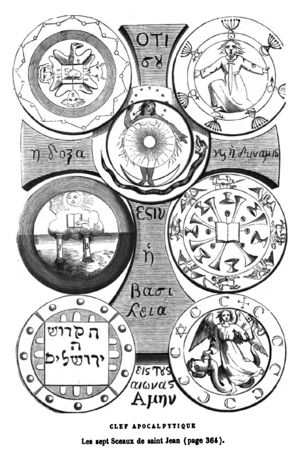Apocalyptic Seals
The Apocalyptic Seals were designed by Miss Clara Rettich according to Rudolf Steiner's sketches for the Congress of the "Federation of European Sections of the Theosophical Society", which took place in Munich from 18 - 21 May 1907. The planetary columns between the seal images were created by Karl Stahl.
The meaning of the seals

According to occult tradition, the seven apocalyptic seals are not directly those seals which are broken at the opening of the book with the seven seals mentioned in Rev 5:1–14. Rather, the apocalyptic seals span a much wider range and represent the imaginatively seen astral archetypes of the entire evolution of humanity on earth in symbolic form. The capitals of the seven planetary columns, on the other hand, represent the level of the spiritual primordial tones or elementary forces, which can only be grasped through inspiration, in plastic forms. Through their transformation of form from pillar to pillar, they give a vivid picture of the planetary stages of world evolution. Due to the limited possibilities, however, the columns for the congress in Munich could initially only be executed as paintings. It was not until 1908/09 that the motifs of the planetary columns were realised in the model building in Malsch, which was built according to Rudolf Steiner's ideas. They were only created in full size for the First Goetheanum.
When designing the first six seal images, Rudolf Steiner was guided by the seals on the Apocalypse shown by the French occultist Éliphas Lévi (1810-1875) in his work Dogme et rituel de la haute magie.[1] Steiner designed the seventh seal, which establishes the reference to the New Jerusalem, entirely independently.[2] He said about the deeper meaning of the seal images:
„They are not arbitrary "symbols" which can be interpreted intellectually, but spiritual-scientific "signs" which must be taken as they correspond to true spiritual science. This does not invent such "signs" out of the intellect or the arbitrary imagination, but only reproduces in them what is really present to spiritual perception in the supersensible worlds. No speculation, no explanation of the intellect, however witty, is appropriate in relation to such signs, since they are not invented but merely provide a description of what the so-called 'seer' perceives in the invisible worlds. The signs reproduced here are descriptions of experiences of the "astral" and the "spiritual" (devachanic) world. The "seals" of the first seven panels represent such real facts of the astral world, and the seven "pillars" represent such facts of the spiritual world. But while the seals directly represent the experiences of "spiritual seeing", this is not the case in the same way with the seven pillars. For the perceptions of the spiritual world cannot be compared with "seeing" but rather with "spiritual hearing". It is important not to think of this as being too similar to "hearing" in the physical world, for although it can be compared to it, it is still very dissimilar. The experiences of this spiritual hearing can only be expressed in a picture if they are translated from "sound" into form. This is what has happened with these "pillars", whose essence can only be understood if one thinks of the forms as plastic (not painted).
In the sense of spiritual science, the causes of the things of the physical world lie in the supersensible, the invisible. What reveals itself physically has its archetypes in the astral world and its spiritual primal forces (primal tones) in the spiritual world. The seven seals give the astral archetypes of the development of humanity on earth in the sense of spiritual science. When the "seer" on the "astral plane" follows this development into the times of the distant past and the distant future, it presents itself to him in the given seven seal pictures. He has nothing to invent, but merely to understand the facts which he perceives spiritually...“ (Lit.:GA 284, p. 91)
Literature
- Rudolf Steiner, Alexandra Riggins: Die sieben apokalyptischen Siegel, Triskel Verlag 2005, ISBN 978-3-905893-02-1
- Rudolf Steiner: Lucifer – Gnosis, GA 34 (1987), ISBN 3-7274-0340-3 English: rsarchive.org German: pdf pdf(2) html mobi epub archive.org
- Rudolf Steiner: Die Apokalypse des Johannes, GA 104 (1985), ISBN 3-7274-1040-X English: rsarchive.org German: pdf pdf(2) html mobi epub archive.org
- Rudolf Steiner: Aus der Bilderschrift der Apokalypse des Johannes, GA 104a (1991), ISBN 3-7274-1045-0 English: rsarchive.org German: pdf pdf(2) html mobi epub archive.org
- Rudolf Steiner: Bilder okkulter Siegel und Säulen. Der Münchner Kongreß Pfingsten 1907 und seine Auswirkungen., GA 284 (1993), ISBN 3-7274-2840-6 English: rsarchive.org German: pdf pdf(2) html mobi epub archive.org
- Rudolf Steiner: Vorträge und Kurse über christlich-religiöses Wirken, V, GA 346 (2001), ISBN 3-7274-3460-0 English: rsarchive.org German: pdf pdf(2) html mobi epub archive.org
 |
References to the work of Rudolf Steiner follow Rudolf Steiner's Collected Works (CW or GA), Rudolf Steiner Verlag, Dornach/Switzerland, unless otherwise stated.
Email: verlag@steinerverlag.com URL: www.steinerverlag.com. Index to the Complete Works of Rudolf Steiner - Aelzina Books A complete list by Volume Number and a full list of known English translations you may also find at Rudolf Steiner's Collected Works Rudolf Steiner Archive - The largest online collection of Rudolf Steiner's books, lectures and articles in English. Rudolf Steiner Audio - Recorded and Read by Dale Brunsvold steinerbooks.org - Anthroposophic Press Inc. (USA) Rudolf Steiner Handbook - Christian Karl's proven standard work for orientation in Rudolf Steiner's Collected Works for free download as PDF. |
References
- ↑ Éliphas Lévi: Dogme et rituel de la haute magie, volume 2, Paris 1861, p. 364 archive.org
- ↑ Bernd Lampe: Das Buch mit den sieben Siegeln, in: Das Goetheanum Nr. 7, 14. February 2014, p. 5 ff.
